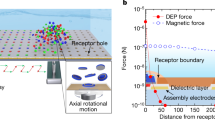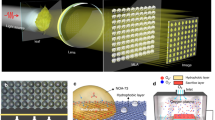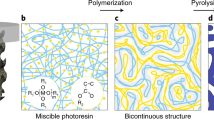Abstract
Data visualization plays a crucial role in our society, as illustrated by the many displays that surround us. In the future, displays may become even more pervasive, ranging from individually addressable image-rendering wall hangings to data displays integrated in clothes1. Liquid-crystal displays (LCDs) provide most of the flat-panel displays currently used. To keep pace with the ever-increasing possibilities afforded by developments in information technology, we need to develop manufacturing processes that will make LCDs cheaper and larger, with more freedom in design. Existing batch processes for making and filling LCD cells2,3 are relatively expensive, with size and shape limitations. Here we report a cost-effective, single-substrate technique in which a coated film is transformed into a polymer-covered liquid-crystal layer. This approach is based on photo-enforced stratification: a two-step photopolymerization-induced phase separation of a liquid-crystal blend and a polymer precursor. The process leads to the formation of micrometre-sized containers filled with a switchable liquid-crystal phase. In this way, displays can be produced on a variety of substrates using current coating technology. The developed process may be an important step towards new technologies such as ‘display-on-anything’ and ‘paintable displays’.
This is a preview of subscription content, access via your institution
Access options
Subscribe to this journal
Receive 51 print issues and online access
$199.00 per year
only $3.90 per issue
Buy this article
- Purchase on Springer Link
- Instant access to full article PDF
Prices may be subject to local taxes which are calculated during checkout




Similar content being viewed by others
References
Farringdon, J., Moore, A. J., Tilbury, N., Church, J. & Biemond, P. D. in Proc. IEEE 3rd Int. Symp. on Wearable Computers 1999 107–113 (IEEE, San Francisco, 1999)
Morozumi, S. in Liquid Crystals: Applications and Uses (ed. Bahadur, B.) Vol. 1, 181 (World Scientific, Singapore, 1990)
Kamiya, H. et al. in SID 01 Digest of Technical Papers, 2001 Int. Symp. Vol. 32, 1354–1357 (Society for Information Display, 2001)
Vaz, N. A., Smith, G. W. & Montgomery, G. P. A light control film composed of liquid crystal droplets in a UV-curable polymer. Mol. Cryst. Liq. Cryst. 146, 1–15 (1987)
Doane, J. W., Vaz, N. S., Wu, B. G. & Zumer, S. Field controlled light scattering from nematic microdroplets. Appl. Phys. Lett. 48, 269–271 (1986)
Hirai, Y., Niiyama, S., Kumaim, H. & Gunjima, T. Phase diagram and phase separation in LC/prepolymer mixture. Proc. SPIE Int. Soc. Opt. Eng. 1257, 2–8 (1990)
Bowley, C. C., Yuan, H. & Crawford, G. P. Morphology of holographically-formed polymer dispersed liquid crystals (H-PDLC). Mol. Cryst. Liq. Cryst. Technol. A 331, 2069–2076 (1999)
Yamada, N., Kohzaki, S., Funada, F. & Awane, K. Axially symmetric aligned microcell (ASM) mode: electro-optical characteristics or new display mode with excellent wide viewing angle. J. Soc. Inform. Disp. 3 4, 155–158 (1995)
Park, E. Y., Taheri, B., West, J. L. & Palffy-Muhoray, P. in SID 00 Digest of Technical Papers, 2000 Int. Symp. Vol. 31, 782–785 (Society for Information Display, 2000)
Vorflusev, V. & Kumar, S. Phase-separated composite films for liquid crystal displays. Science 283, 1903–1905 (1999)
Qian, T., Kim, J.-H., Kumar, S. & Taylor, P. L. Phase-separated composite films: Experiment and theory. Phys. Rev. E 61, 4007–4010 (2000)
Broer, D. J., Lub, J. & Mol, G. N. Wide-band reflective polarizers from cholesteric polymer networks with a pitch gradient. Nature 378, 467–469 (1995)
Kiefer, R., Weber, B., Windscheid, F. & Baur, G. in Proc. 12th Int. Display Conf., Japan Display ’92 547–550 (1992)
Oh-e, M., Ohta, M., Aratani, S. & Kondo, K. in Proc. 15th Int. Display Conf. Asia Display ’95 577–580 (1995)
Bobrov, Y. A. et al. Novel dichroic polarizing materials and approaches to large-area processing. Mater. Res. Soc. Symp. Proc. 508, 225–228 (1998)
Acknowledgements
We thank J. Lub for synthesis of the stilbene dimethacrylate and for discussions.
Author information
Authors and Affiliations
Corresponding author
Ethics declarations
Competing interests
The authors declare that they have no competing financial interests
Rights and permissions
About this article
Cite this article
Penterman, R., Klink, S., de Koning, H. et al. Single-substrate liquid-crystal displays by photo-enforced stratification. Nature 417, 55–58 (2002). https://doi.org/10.1038/417055a
Received:
Accepted:
Issue Date:
DOI: https://doi.org/10.1038/417055a
This article is cited by
-
Optically and spatially templated polymer architectures formed by photopolymerization of reactive mesogens in periodically deformed liquid crystals
NPG Asia Materials (2017)
-
Drops and shells of liquid crystal
Colloid and Polymer Science (2011)
-
High out-of-plane alignment of liquid crystalline methacrylate copolymer bearing photoreactive 4-styrylpyridine moiety
Macromolecular Research (2009)
-
Synthesis and dual alignment of liquid crystalline polymethacrylate bearing 4-styrylpyridine and biphenylene moieties
Macromolecular Research (2009)
-
Patterning surfaces with functional polymers
Nature Materials (2008)
Comments
By submitting a comment you agree to abide by our Terms and Community Guidelines. If you find something abusive or that does not comply with our terms or guidelines please flag it as inappropriate.



